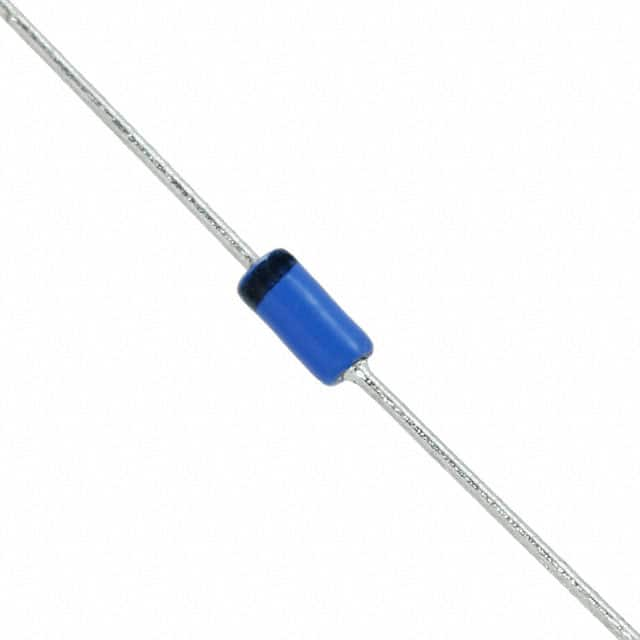BAT43 Diode
Product Overview
Category
The BAT43 diode belongs to the category of Schottky diodes.
Use
It is commonly used in electronic circuits for rectification and voltage clamping applications.
Characteristics
- Low forward voltage drop
- Fast switching speed
- High current capability
Package
The BAT43 diode is typically available in a SOD-123 package.
Essence
This diode is essential for preventing reverse voltage breakdown in electronic circuits.
Packaging/Quantity
It is usually packaged in reels or tubes, with quantities varying based on manufacturer specifications.
Specifications
- Maximum repetitive peak reverse voltage: 30V
- Average forward current: 200mA
- Forward voltage drop: 0.36V at 1A
- Reverse leakage current: 0.5µA at 25°C
Detailed Pin Configuration
The BAT43 diode has two pins, anode and cathode, with the anode being connected to the positive side of the circuit and the cathode to the negative side.
Functional Features
- Fast recovery time
- Low power loss
- High efficiency
Advantages and Disadvantages
Advantages
- Low forward voltage drop reduces power dissipation
- Fast switching speed allows for high-frequency operation
- Small form factor
Disadvantages
- Limited maximum reverse voltage capability compared to other diode types
- Higher cost compared to standard silicon diodes
Working Principles
The BAT43 diode operates based on the Schottky barrier principle, where the metal-semiconductor junction allows for faster switching and lower forward voltage drop compared to conventional PN-junction diodes.
Detailed Application Field Plans
Power Supplies
Used in rectifier circuits to convert AC to DC in power supplies.
Signal Demodulation
Applied in radio frequency (RF) circuits for demodulating signals.
Overvoltage Protection
Utilized in circuits to protect sensitive components from overvoltage conditions.
Detailed and Complete Alternative Models
- 1N5819: Similar characteristics and package type
- SS14: Comparable specifications and application range
In conclusion, the BAT43 diode is a crucial component in electronic circuits due to its fast switching speed, low forward voltage drop, and high current capability. Its applications span across various fields including power supplies, signal demodulation, and overvoltage protection. While it has certain limitations, its advantages make it a preferred choice in many electronic designs.
Word count: 389
Senaraikan 10 soalan dan jawapan biasa yang berkaitan dengan aplikasi BAT43 dalam penyelesaian teknikal
What is BAT43?
- BAT43 is a Schottky barrier diode commonly used in electronic circuits for its low forward voltage drop and fast switching characteristics.
What are the typical applications of BAT43?
- BAT43 is often used in rectification, freewheeling, and protection circuits in various electronic devices and power supplies.
What is the maximum forward voltage of BAT43?
- The maximum forward voltage of BAT43 is typically around 0.5V at a forward current of 1A.
What is the reverse breakdown voltage of BAT43?
- The reverse breakdown voltage of BAT43 is around 30V.
Can BAT43 be used for high-frequency applications?
- Yes, BAT43 is suitable for high-frequency applications due to its fast switching speed.
What is the maximum forward current rating of BAT43?
- The maximum forward current rating of BAT43 is typically around 200mA.
Is BAT43 suitable for low-power applications?
- Yes, BAT43 is commonly used in low-power applications due to its low forward voltage drop.
What are the temperature considerations for BAT43?
- BAT43 has a wide operating temperature range, typically from -65°C to 125°C, making it suitable for various environments.
Can BAT43 be used in reverse polarity protection circuits?
- Yes, BAT43 is often used in reverse polarity protection circuits due to its low reverse leakage current and fast response time.
Are there any alternatives to BAT43 for similar applications?
- Yes, other Schottky diodes such as BAT85, 1N5819, and SS14 can be used as alternatives to BAT43 for similar applications.


